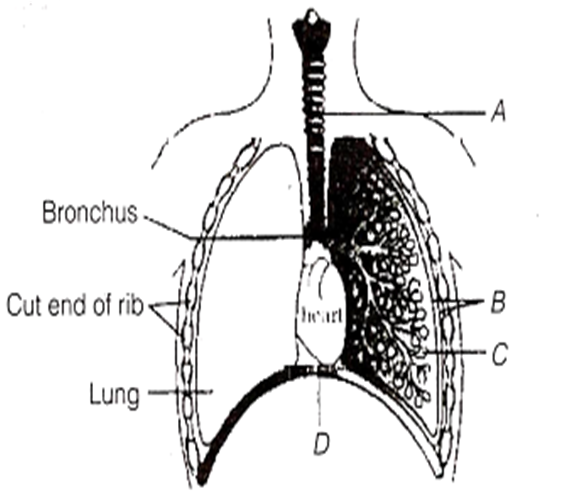 Multiple Choice Questions
Multiple Choice QuestionsAfter forceful inspiration, the amount of air that can be breathed out by maximum forced expiration is equal to
Inspiratory Reserve Volume (IRV) + Expiratory Reserve Volume (ERV) + Tidal Volume (TV) + Residual Volume (RV)
IRV + RV + ERV
IRV + TV + ERV
TV + RV + ERV
The figure shows a diagrammatic view of human respiratory system with labels A, B, C and D. Select the option, which gives correct identification and main function and/or characteristic.

A - trachea - long tube supported by complete cartilaginous rings for conducting inspired air
B - pleural membrane-surround ribs on both sides to provide cushion against rubbing
C - alveoli - thin walled vascular bag-like structures for exchange of gases
D - lower end of lungs - diaphragm pulls it down during inspiration
The volume of air that can be breathed in by maximum forced inspiration over and above the normal inspiration is called
expiratory reserved volume
inspiratory reserved volume
vital capacity
inspiratory capacity
Choose the correct statements with regard to human respiration.
I. Inspiration is facilitated by the contraction of phrenic and internal intercostal muscles.
II. Healthy human can inhale or exhale about 2000 to 3000 mL of air per minute.
III. Functional residual capacity represent the volume of left out air in lungs after expiration.
IV. Total lung capacity is the total volume of air that can be accomodated in the lung after forced inspiration.
The correct answer is
I, III
II, IV
III, IV
I, II
Taenidia is the vital component of which system in human body?
Respiratory system
Digestive system
Excretory system
Reproductive system
Arrange the following compounds formed in respiration based on their C-atoms in ascending order.
I. Pyruvic acid
II. -ketoglutaric acid
III. Citric acid
IV. Malic acid
The correct answer is
IV, I, II and III
I, IV, II and III
I, II, IV and III
I, IV, III and II
Read the following statements.
I. Adam's apple in man is formed by thyroid cartilage.
II. The maximum volume of air a person can breath in after forced expiration is vital capacity.
III. About 20-25% of CO, is transported as carbaminohaemoglobin.
IV. Pneumotaxic centre lies in pons.
The correct statement(s) is
Only I
I, II
I, II, III
I, II, III, IV
According to Boyle's law, the product of pressure and volume is a constant. Hence,
if volume of lungs is increased, the pressure decreases disproportionately
if volume of lungs is increased, the pressure remains the same
if volume of lungs is increased, the pressure decreases proportionately
if volume of lungs is increased, the pressure also increases proportionately
When the organic acid is oxidised in respiration, the value of R.Q. becomes
zero
one
less than one
more than one
